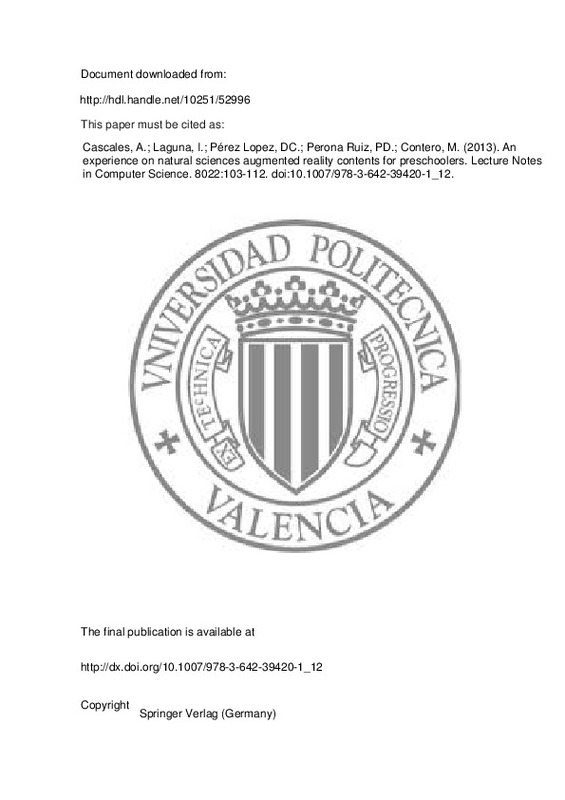Barnett, W.S.: Effectiveness of Early Educational Intervention. Science 333(6045), 975–978 (2011)
OECD: Investing in high-quality early childhood education and care (ECEC). OECD Publishing, http://www.oecd.org/dataoecd/0/28/48980282.pdf (retrieved)
Campos, P., Pessanha, S.: Designing Augmented Reality Tangible Interfaces for Kindergarten Children. In: Shumaker, R. (ed.) Virtual and Mixed Reality, HCII 2011, Part I. LNCS, vol. 6773, pp. 12–19. Springer, Heidelberg (2011)
[+]
Barnett, W.S.: Effectiveness of Early Educational Intervention. Science 333(6045), 975–978 (2011)
OECD: Investing in high-quality early childhood education and care (ECEC). OECD Publishing, http://www.oecd.org/dataoecd/0/28/48980282.pdf (retrieved)
Campos, P., Pessanha, S.: Designing Augmented Reality Tangible Interfaces for Kindergarten Children. In: Shumaker, R. (ed.) Virtual and Mixed Reality, HCII 2011, Part I. LNCS, vol. 6773, pp. 12–19. Springer, Heidelberg (2011)
Lim, J., Kim, S.: A Study on Markerless AR-based Infant Education System using CBIR. Communications in Computer and Information Science 78, 52–58 (2010)
Chen, C.H., Su, C.C., Lee, P.Y., Wu, F.G.: Augmented Interface for Children Chinese Learning Technologies. In: 7th IEEE International Conference on Advanced Learning Technologies, pp. 268–270. IEEE Press, New York (2007)
Azuma, R.: A Survey of Augmented Reality. Presence: Teleoperators and Virtual Environments 6(1), 355–385 (1997)
Winkler, T., Herczeg, M., Kritzenberger, H.: Mixed Reality Environments as Collaborative and Constructive Learning Spaces for Elementary School Children. In: Barker, P., Rebelsky, S. (eds.) Proceedings of World Conference on Educational Multimedia, Hypermedia and Telecommunications 2002, pp. 1034–1039. AACE, Chesapeake (2002)
Hsieh, M.C., Lee, J.S.: AR Marker Capacity Increasing for Kindergarten English Learning. In: International Multi Conference of Engineers and Computer Scientists, vol. 1, pp. 663–666 (2008)
Hsieh, M.C., Lin, H.C.K.: Interaction Design Based on Augmented Reality Technologies for English Vocabulary Learning. In: Wong, S.L., et al. (eds.) Proceedings of the 18th International Conference on Computers in Education, vol. 1, pp. 663–666. Asia-Pacific Society for Computers in Education (2010)
Lee, H., Lee, J.: Mathematical Education Game Based on Augmented Reality. Technologies for E-Learning and Digital Entertainment, 442–450 (2008)
Hyun, E., Choi, K., Kim, G.J., Han, J., Jo, M., Kim, N.: Delphi Survey on the Use of Robot Projector based Augmented Reality in Dramatic Activity for Young Children. International Journal of Digital Content Technology and its Applications 5(11), 272–282 (2011)
Kim, H.M., Song, T.H., Jung, S.M., Kwon, K.H., Jeon, J.W.: Virtual Storyteller Using Marker Based AR and FPGA. In: IEEE 54th International Midwest Symposium on Circuits and Systems, pp. 1–4. IEEE Press, New York (2011)
Dunleavy, M., Dede, C., Mitchell, R.: Affordances and Limitations of Immersive Participatory Augmented Reality Simulations for Teaching and Learning. Journal of Science Education and Technology 18, 7–22 (2009)
Martín-Gutiérrez, J., Saorín, J.L., Contero, M., Alcañiz, M., Pérez-López, D., Ortega, M.: Design and validation of an augmented book for spatial abilities development in engineering students. Computers & Graphics 34(1), 77–91 (2010)
Cook, T.D., Campbell, D.T., Day, A.: Quasi-experimentation: Design and Analysis Issues for Field Settings, pp. 19–21. Houghton Mifflin, Boston (1979)
Buendía, L., Colás, P., Hernández-Pina, F.: Métodos de Investigación en Psicopedagogía. McGraw Hill, Madrid (1997)
[-]







![[Cerrado]](/themes/UPV/images/candado.png)

